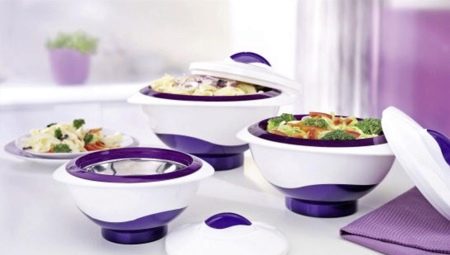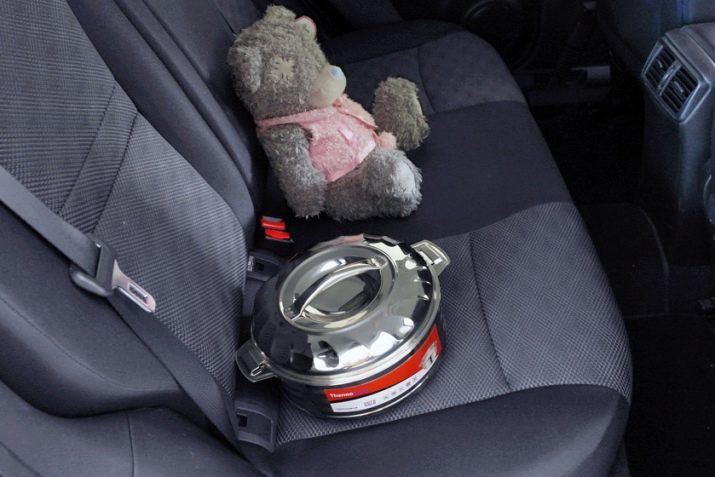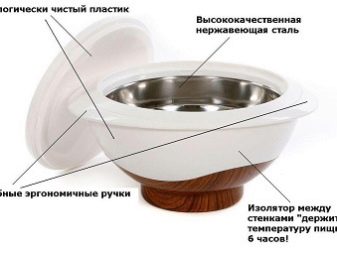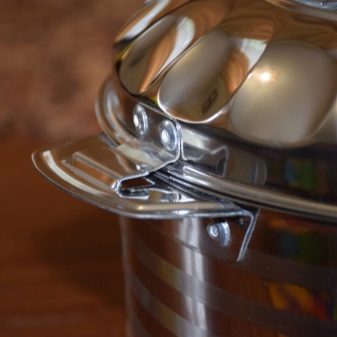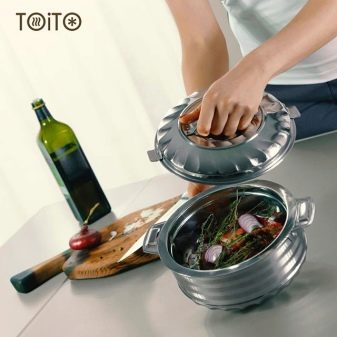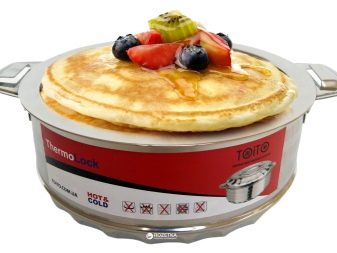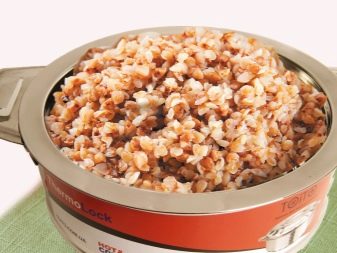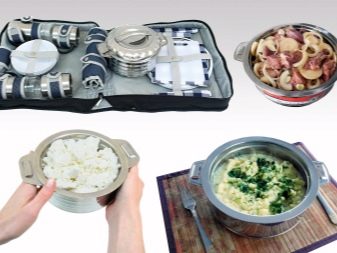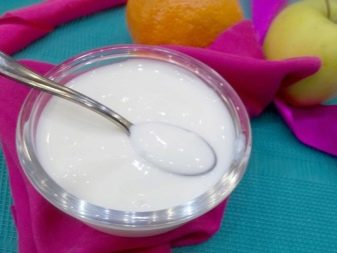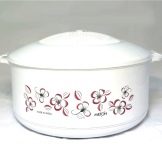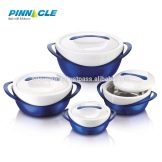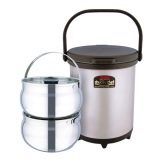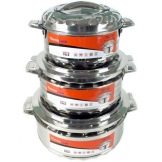Thermos in everyday life is called a special insulating dish. It is able to maintain a higher or lower temperature of food products for a long time compared with the temperature indicator of the environment. The patent for the invention of a thermos in 1907 was received by the German businessman Reinhold Burger, who developed it on the basis of a Dewar vessel, and considerably improved it.
Nowadays, not only drinks and broths are stored in a thermos. The solution to how to keep warm and tasty homemade food on the road is the so-called pot-thermos or heat-pan.
Device and principle of operation
By its appearance, a thermal casket is similar to a common stainless steel kitchen utensil. But its internal structure consists of a unique double insulation system. Between the layers of such dishes fixed insulating material, which helps maintain a certain temperature. A layer of thermal insulation allows you to keep inside and cold.
If you put frozen food in a thermos pot, then for about 4-6 hours it can work as a small refrigerator.
The cover of the heat pan has a special bayonet lock. After placing the products in the pan, close the lid and set it by turning it so that the locks on the handles fit into the grooves. Now the pot-thermos can be transported, even with a strong shaking, all the food inside it is reliably protected and will not leak out. In addition, such a lock prevents the spread of odors.
Advantages and disadvantages
When choosing kitchen utensils, it should be noted that thermal cassettes have the following advantages:
- Food-grade stainless steel does not absorb smells of food placed in it and is very easy to clean with both hands and a dishwasher;
- the thermoware very well maintains both warm and cold temperatures inside;
- preserves useful substances that can be lost during heating;
- has a sealed bayonet lock;
- better preserves the taste and aroma of dishes, compared with reheating;
- it is produced both in small (1 liter) and in large volumes (3-5 liters, and even 7);
- It is convenient to take small saucepans to work as lunch boxes.
The disadvantages include the high price of some brands of heat-sinks, as well as the fact that they cannot be used on the stove and in the microwave oven.
What can be stored and how to use?
The pot-thermos is ideal for languishing any porridge, it is only after cooking in the usual pot to put it inside the heat pan, and the result will be as amazing as the cereal was languishing in a Russian oven.
In this dish you can transport freshly baked pies, belyashes, muffins, pancakes. Thermo pans preserve the taste and aroma of meat, poultry, fish, pasta and vegetables. If you have a long road out of town for a picnic, then the mini-fridge perfectly preserves the freshness of seafood for grilling, any vegetables and milk.
Thermos pans with a sealed lid perfectly preserve the freshness of marinated meat for kebabs.
Such dishes are not designed to cook in her food, but it is easy to make yogurt or kefir. To do this, put in a liter of warm milk and put in it one or two tablespoons of natural yogurt. The mixture should be mixed and allowed to stand with the lid open for 5-8 minutes, then close the bayonet lock and wait 3-4 hours. After that, homemade yogurt will be ready to eat. If instead of yogurt put kefir, you can get a delicious cottage cheese.
Range
On sale most often you can find heat-casts of the following brands.
- Milton. This Indian company produces elegant and functional heating casings in an affordable price range. They are environmentally friendly and safe, made of high quality stainless steel. This dish perfectly retains heat and cold for about 6-8 hours. It is presented in various volumes (from 1 to 5 liters) and in inexpensive sets. All pans are equipped with handles suitable for grip.
- Pinnacle. The manufacturer of these saucepans is also India. The dishes are made of high-quality plastic, which means that it cannot be washed in a dishwasher and kept near sources of heat. Both the individual heat boxes and the sets have an attractive design in white and violet colors. The volume of saucepans is basically 3-6 liters.
- TOiTO. This is another kind of Indian-made tableware. It is affordable and made of food steel. The assortment of this brand is widely represented by hotpans of various volumes, ranging from small one-liter saucepans. The sets are different, for example, there is a set consisting of small saucepans of 1, 1.5 and 2.5 liters, and of larger dishes - of 2.5, 3.5 and 5 liters.
- Thermos. The products of this most famous brand of thermowires are made in China. They are the most expensive in price, but very high quality. These thermos pans most often have volumes of 1.5 liters, 3 and 4.5. They have a removable inner pan in which they can be cooked on the stove and then put in a thermal container. This is the so-called thermoukking technology.
Thermal pans with an airtight lid are ideal for transporting ready meals or perishable foods. They can take with them to work, cottage, travel. Modern pans-thermos have a stylish design, environmentally safe and easy to clean. Several of these pans of different sizes will surely help you out with daily cooking and in preparation for the holiday.
Review TOiTO hotplate in the next video.
